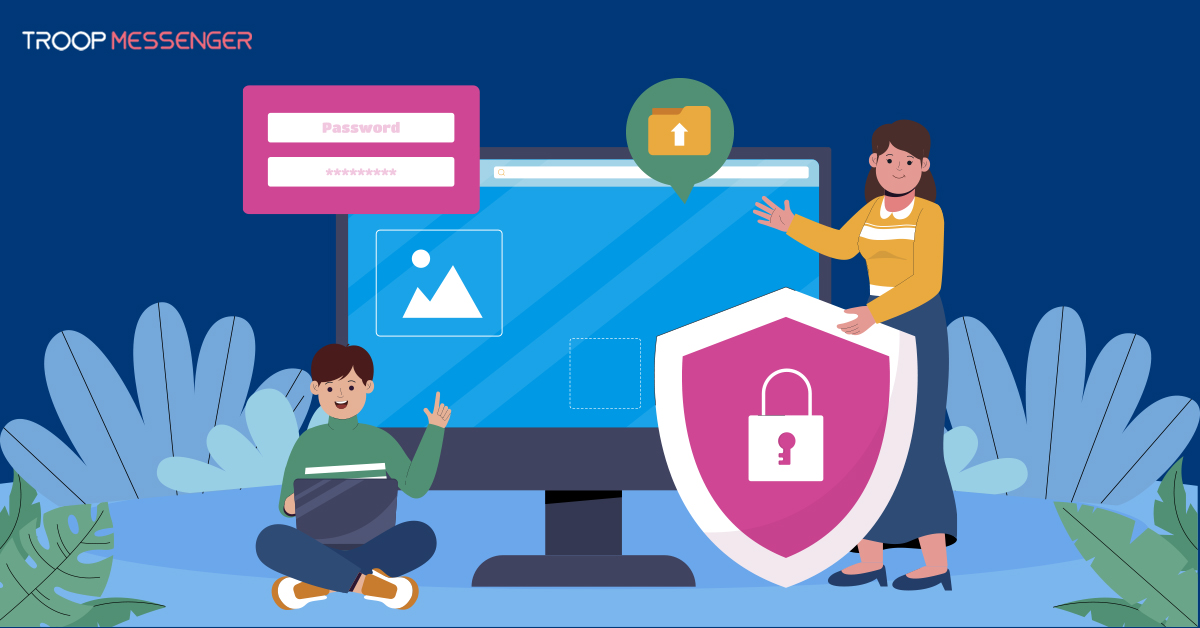Connect with us

Cybersecurity in B2B Tech: Safeguarding Communication Channels
B2B tech companies often handle sensitive and highly confidential information such as financial data, patents, copyrights, proprietary information, and trademarks. This information can be incredibly valuable to competitors and other malicious actors.
Cybercriminals can commit fraud, account takeovers, social engineering, or industry espionage with stolen information from B2B tech communication channels.
Cyberattacks on B2B companies are increasing every year, and many of them are financially motivated. They usually involve forms of ransomware and extortion. Verizon’s research showed that 62% of these attacks in 2024 led to a median loss of $46,000.
Because of this, companies in this niche will need secure and robust communication channels to keep messages safe from unauthorized and malicious parties.
This is exactly what cybersecurity means for B2B niche companies - protecting information systems and their subsequent data from unauthorized access, modification, use, and destruction.
Don’t wait until it's too late to take action. Be proactive and protect your valuable communication channels.
Here are some of the best expert-vetted cybersecurity measures for safeguarding your communication channels as a company in the B2B tech niche.
1. Get Professional Education and Training For You and Your Team
In 2022, the World Economic Forum found that 95% of all cybersecurity incidents could be traced back to human error. Such numbers highlight the value of educating and training your fellow team members on various cyber threats and measures they can take to keep these risks at bay.
But where do you start?
We recommend starting with training and education on phishing attacks.
- Phishing is a type of attack that involves tricking members of an organization into giving up highly confidential and personal information about fellow employees or the organization as a whole.
- Scammers and cybercriminals who use this type of attack often pose as legitimate organizations such as banks, telcos, and social media companies like Gmail, Twitter (X), Meta (Facebook), and Instagram.
They create a sense of urgency that pushes you to give up information such as account passwords, credit cards, and social security numbers. This brand impersonation gets the user to lower their guard and trust much faster and easier.
Phishing attacks occur through various communication channels, including phone, text messages, and email. However, email is the most common channel used in phishing attacks.
According to Statista, approximately 85% of all organizations experienced phishing attacks in 2022, 70% of which were done through email. Such numbers show just how rampant and damaging phishing attacks have become for organizations.
So, how do you avoid taking the bait in such an attack?
Education on how to identify phishing attempts can significantly reduce the risk of compromise. Here’s what to keep in mind when doing so:
- Training should cover red flags like generic greetings, suspicious sender addresses, urgency tactics, and grammatical errors.
- Be wary of urgent tactics used. Phishing attempts frequently create a sense of urgency, pressuring you and your team members to take immediate action (e.g., "Click here to avoid account suspension!").
- Role-playing phishing simulations can develop you and your team members' awareness and response skills. Training exercises that simulate phishing attempts allow your team members to practice identifying red flags and following safe protocols in a controlled environment, strengthening their ability to respond effectively to real-world attacks.
- Have training and education in social engineering. This can help you identify social engineering tactics like impersonation, pretexting (creating a false scenario to gain trust), and urgency.
2. Use Encrypted Communication Channels
Encryption is the process of protecting your data as you communicate it from the sender to the recipient. It’s designed to allow only the sender and receiver of the message to read and understand the messages.
In more technical terms, encryption scrambles data into an unreadable code, ensuring only authorized parties with a decryption key can access the information.
This reduces the risk of malicious parties, including hackers, cybercriminals, and spying organizations, intercepting your messages and using them for their own gain.
Data privacy is very important to companies in the B2B niche. That’s why we recommend using encrypted communication channels like Troop Messenger when communicating with your team members.
Troop Messenger offers a comprehensive and solid communication platform that's secured with encryption technology. This solution has a ton of features that allow seamless collaboration, crystal clear calls, simplified information management, and scalability options.
3. Add Extra Layers of Security With Multi-Factor Authentication
B2B tech companies must go beyond traditional username and password combinations to protect their valuable communication channels. Fortunately, Multi-Factor Authentication (MFA) offers an effective solution for this.
MFA is a security process that requires people attempting to access an account to provide two or more verification factors to access, in this case, a communication channel account.
Instead of simply prompting users to give usernames and passwords, MFA requires more credentials for validation, such as a PIN sent to your phone number, biometrics, such as facial recognition, and a physical token.
MFA is a must for B2B tech companies because it's an effective solution for enhancing security so that unauthorized parties do not breach their valuable databases.
It also reduces the risk of phishing attacks, as it requires more credentials for user verification. This makes it harder for people attempting to illegally gain access even if they have stolen credentials.
4. Secure Your Network(s)
For B2B tech companies, networks are the backbone of communication and data exchange. These networks connect various systems, devices, and users, facilitating seamless collaboration and information flow.
However, this interconnectedness also makes them prime targets for cybercriminals. Securing your networks is one of the best practices that will safeguard your communication channels and protect sensitive or highly confidential data.
Failing to secure your networks only serves as an open invitation for hackers who could exploit vulnerabilities to steal highly confidential data.
So, how do you secure your networks as a B2B tech company?
- Use Firewalls and Intrusion Detection Systems (IDS). Firewalls act as the first line of defense by filtering incoming and outgoing traffic based on predetermined security rules. IDS takes it further as they monitor network traffic for any suspicious activity and alert you on the same.
- Consider VPNs. VPNs are a simple, cost-friendly, and highly secure way of protecting your internet connection. They encrypt data transmitted over the Internet, allowing you and your remote team members to connect securely. Fortunately, many VPNs offer free trials that allow you a preview of their features before you commit to purchasing them.
- Conduct regular security audits and penetration testing. This is a proactive approach to keeping your networks safe and, ultimately, your communication channels. But what is penetration testing? Penetration testing involves ethical hackers (the good guys) attempting to exploit vulnerabilities in your system, just like a real cybercriminal might. This helps expose any weaknesses before they can be used against you.
5. Keep Your Systems and Devices up to Date
It's this simple - Outdated software and hardware can have vulnerabilities that cybercriminals exploit to access to your networks and communication channels.
Some of these systems and devices that B2B tech companies use include servers, databases, laptops, workstations, smartphones, networking equipment, and software apps.
Enabling automatic updates on firmware, drivers, systems, and applications will make the entire process easy. But remember, it's always important to test these updates before deployment. This helps identify potential compatibility issues and ensures that updates do not disrupt business operations.
6. Have you Ever Heard of Access Controls? Here’s Why You Should Implement Them
Access controls, as the name suggests, are security measures that limit or control people who can access specific company files in a computing environment.
B2B tech companies handle vast amounts of sensitive data as mentioned before. Access controls ensure that this data is only accessible to individuals who need it to perform their job functions. This computer security measure reduces the risk of data leaks and breaches.
It's important to note that not all threats come from external sources. Insiders can also cause damage knowingly or unknowingly. Fortunately, access controls help mitigate these risks by limiting access to critical data.
It ensures team members have access to the necessary data/information for their roles and nothing more.
Here’s how access controls impact communication channels:
- Being one of the most used communication channels, emails are the primary target for cyberattacks. Over 75% of cyberattacks targeted at communication channels start with emails.
- But with solid access controls, specific emails will only be accessible to specific people, reducing the risk of phishing attacks and improving data-security.
- Tools like Slack, Microsoft Teams, and Troop Messenger facilitate real-time communication and collaboration. Access controls help regulate who can join channels, view messages, and share files. This ensures that conversations of a sensitive nature, together with confidential documents shared on these platforms, remain secure.
So, how do you implement access controls that safeguard your communication channels as a B2B tech company:
- Start with outlining clear access control policies: You and your organization need to outline clear policies that define personnel that can access specific company resources and under what conditions. These policies should cover all communication channels, including email, messaging platforms, and file-sharing systems.
- We recommend using role-based access controls: This involves using permission-based user roles within your organization. For example, restrict access to highly confidential emails or group chats to only those who need this information to perform their duties and no one else.
- Review and update access controls regularly: Conduct periodic reviews of access permissions to ensure they are still appropriate and relevant. Remove access for users who no longer need it and adjust the relevant permissions as job roles change.
Conclusion
In Conclusion, These are the Best Cybersecurity Measures That’ll Safeguard Your B2B Tech Communication Channels
Companies in the B2B niche face the enormous challenge of communicating securely through various channels. That’s because many malicious actors would massively benefit from intercepting these channels and stealing that valuable information.
There are plenty of reasons why you ought to protect your communication channels if you're in the B2B tech industry. Mitigating financial risks and protecting sensitive information, including customer data, IP, financial data, copyrights, and patents, are some of the major reasons why communication channels are worth protection.
In this article, we looked at six high-security measures that cyber-security experts recommend.
Here’s a quick recap of these measures that’ll safeguard your B2B tech communication channels:
- Email is one of the most targeted communication channels for phishing attacks. This type of attack involves brand impersonation and creating a sense of urgency to trick users into giving up their personal and highly confidential information. B2B tech companies should train, educate, and simulate real-world situations around phishing attacks to safeguard their communication channels.
- As a B2B tech company, your communication channels should be encrypted. Encryption allows your data to be safely passed across communication channels without the risk of spying agencies, hackers, and malicious actors intercepting it and using that information for their own gain.
- MFA is a great and effective way to secure your communication channels. It adds an extra layer of protection for your communication accounts when logging in. This significantly reduces the risk of phishing.
- B2B tech companies rely on secure networks to protect sensitive data exchange. Firewalls, IDS, and VPNs are key tools to secure networks, while regular security audits and penetration testing proactively identify and fix network security vulnerabilities before hackers can exploit them.
- Outdated software and hardware in B2B tech firms create security holes for attacker(s). Regularly updating firmware, drivers, and applications helps patch these vulnerabilities, but testing updates first avoids disrupting business functions.
- B2B tech companies constantly deal with highly confidential data. Access controls limit access to this data to authorized personnel only. This ensures secure communication channels by restricting access to emails, messaging platforms, and shared files, especially those containing sensitive information.








